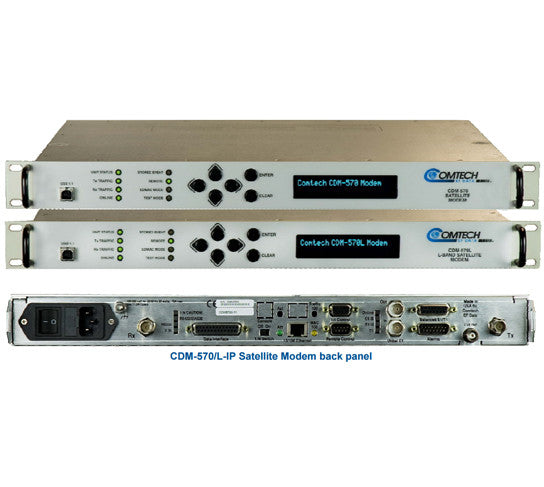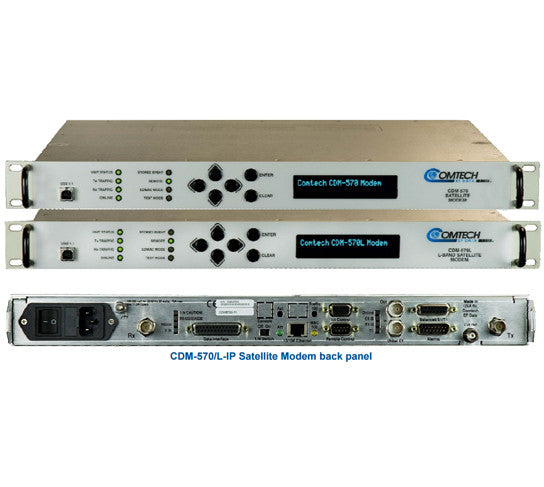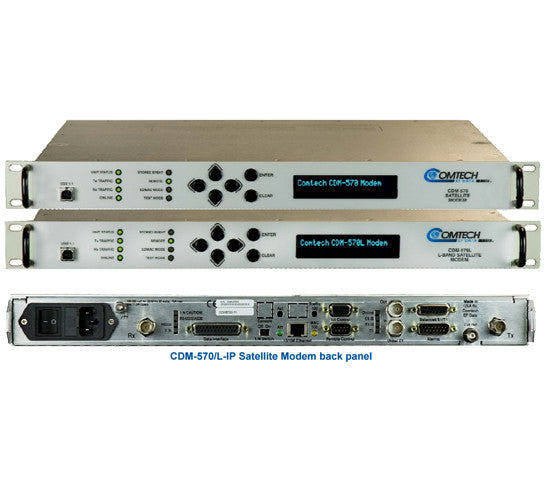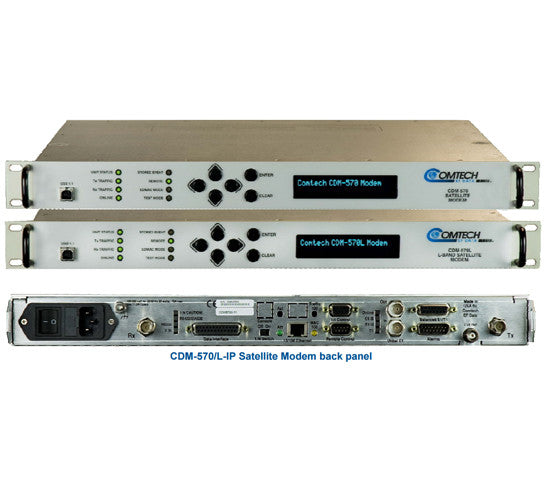Comtech EF Data
Comtech EF Data CDM-570L/IP L-Band Satellite Modem
Comtech EF Data CDM-570L/IP L-Band Satellite Modem
Couldn't load pickup availability
CDM-570/L FEATURES
- Data rate range from 2.4 kbps to 9.98 Mbps
- CDM-570 & CDM-570-IP: 50 to 90 or 100 to 180 MHz IF range
CDM-570L & CDM-570L-IP: 950 to 2000 MHz IF range - Modulation types: BPSK, QPSK, OQPSK, 8-PSK, Patented 8-QAM (U.S. patent 7,254,188), 16-QAM
- Forward Error Correction (FEC) choices include Turbo Product Code (TPC), Viterbi, Reed- Solomon, and Trellis Coded Modulation (TCM)
- Data Interfaces: EIA-422/530, V.35, G.703 T1/E1 (option), 10/100Base-T Ethernet (option)
- Standards based management via SNMP, Web, or Telnet
- Symmetric as well as asymmetric operation for maximum bandwidth efficiency
- Support for mesh, star and hybrid network topologies
- E1 RAN Optimization (option)
- G.703 clock extension for IP backhaul (option)
- Fast acquisition demodulator (± 32 kHz acquisition range, 64 kbps, Rate 1/2 QPSK: 150 ms average)
- Automatic Uplink Power Control (AUPC)
- Embedded Distant-end Monitor and Control (EDMAC/EDMAC2)
- Redundancy options
- CDM-570 & CDM-570-IP: FSK communications to CSAT-5060 or KST-2000A
- CDM-570L & CDM-570L-IP: 10 MHz reference for BUC, FSK communications and optional BUC power supply
- CDM-570L & CDM-570L-IP: 10 MHz reference and power supply for LNB
- Optional, integrated IP Module with 10/100Base-T Ethernet port (CDM-570-IP and CDM-570L-IP)
- Static IP routing for unicast and multicast
- Header and payload compression for maximum efficiency
- IGMP v1 and v2
- VLAN capability with 802.1Q compliant QoS
- Vipersat Management System (VMS) integration
CDM-570 PSK DIGITAL SATELLITE MODEM
The CDM-570 and the CDM-570L are Comtech EF Data’s entry-level satellite modems that provide industry leading performance and flexibility in a 1 RU package at a very competitive price. Designed to address the market for low-cost terminals, the modems are available with 70/140 MHz or L-Band IF and EIA-530/-422, V.35, EIA-232 and G.703 data interfaces. An optional Internet Protocol (IP) Module with 10/100Base-T Ethernet port is available for IP-centric applications. For cellular backhaul, the CDM-570/L and CDM-570/LIP also offer E1 RAN Optimization as an option.
TURBO PRODUCT CODING
The optional Turbo Product Codec delivers significant performance improvement when compared to Viterbi with concatenated Reed-Solomon. It offers increased coding gain, lower decoding delay, and significant bandwidth savings compared to traditional FEC.
EDMAC & AUPC OPERATION
The CDM-570/L-IP has the ability to monitor and control the distant end of a point-to-point satellite link using EDMAC or EDMAC2. User data is framed and bits are added to pass control, status, and AUPC information. This is transparent to the user.
FAST FEATURE ENHANCEMENTS
The FAST codes make it easy to upgrade the modem capability in the field. New features can be added on site, using FAST access codes purchased from Comtech EF Data that can be entered via the front panel.
MANAGEMENT
The modems support SNMP, web-based and command line interfaces for management. The modems can also be configured and monitored from the front panel, or through the remote M&C port (for non-IP mode of operation). Ten complete RF configurations may be stored in the modem. An event log stores alarm and status information in non-volatile RAM, while the link statistics log stores link performance (Eb/No and AUPC performance) for monitoring and reporting purposes.
E1 RAN OPTIMIZATION (POINT-TO-POINT)
Comtech EF Data’s RAN Optimization technology significantly reduces the WAN (satellite) bandwidth required to carry an E1 bearer used for cellular backhaul. It provides the user complete control over the desired level of optimization and link quality. Depending on the traffic profile, typical bandwidth reduction of 30-35% can be achieved with little or no impact to the voice quality. The WAN bandwidth can be reduced by as much as 60% relative to the ingress data rate, allowing users to achieve desired bandwidth savings and voice quality. The CDM-570/L provides usage statistics to assist with link monitoring. E1 RAN optimization cannot be used simultaneously with the IP Module.
G.703 CLOCK EXTENSION
Cellular networks require precise synchronization of base stations, which is a challenge when using IP backhaul. Most operators are forced to use GPS-based external equipment for site synchronization. CDM-570/L-IP offers a G.703 clock extension option that propagates a high stability reference from hub to the remote. This process does not require additional bandwidth.
IP MODULE
With its innovative architecture and support for advanced capabilities, IP Module-equipped versions of the CDM-570/L allow for efficient IP networking and transport over satellite. The CDM-570/L-IP supports a wide range of applications and network topologies.
TYPICAL USERS
|
COMMON APPLICATIONS
|
CDM-570L REAR PANEL

HEADER COMPRESSION OPTION
Configurable on a per route basis, header compression reduces the bandwidth required for VoIP by as much as 60%. Example: A G.729 voice codec, operating at 8 kbps, requires 32 kbps bandwidth once encapsulated into an IP/UDP/RTP frame. With compression, the same voice call needs only 10.8 kbps total WAN satellite bandwidth. Typical Web/HTTP traffic can also be reduced by 10% via IP/TCP header compression.
PAYLOAD COMPRESSON OPTION
Configurable on a per route basis, payload compression can reduce the required satellite bandwidth by up to 40%.
QUALITY OF SERVICE (QOS) OPTION
The modems support multi-level QoS to reduce jitter and latency for real time traffic, provides priority treatment to mission critical applications and allows non-critical traffic to use the remaining bandwidth. Supported modes are:
- DiffServ – Industry-standard method of providing QoS enabling seamless co-existence in networks that implement DiffServ.
- Max/Priority – Provides eight levels of traffic prioritization with the ability to limit maximum traffic per priority class
- Min/Max – Provides a Committed Information Rate (CIR) to each user defined class of traffic with the ability to allow a higher burstable rate depending on availability
VIPERSAT MANAGEMENT SYSTEM
- Dynamic SCPC carrier allocation & true bandwidth-on-demand
- User-defined policies for upstream carrier switching
- Star and full mesh capabilities using single hop on-demand
- Advanced switching takes advantage of using other modulation/forward error correction combinations
- Guaranteed bandwidth capability
VMS Network & Bandwidth Management
A Vipersat-powered network integrates these advanced modems with a powerful network management tool, the Vipersat Management System (VMS). In addition to the traditional monitoring and control of the CDM-570/L-IP modems and the CDD-564/L and CDD-562L demodulators, the VMS allows these devices to share bandwidth, and when needed, switch automatically to a dedicated SCPC channel. In a Vipersat-powered network, the CDM-570/L-IP modem takes advantage of its fast acquisition demodulation to allow it to operate in a shared mode. Inbound transmissions (from remote to hub) can be switched from a shared Selective Time Division Multiple Access (STDMA) mode to a dedicated Single Carrier Per Channel (SCPC) connection via a variety of user defined policies or triggers. This enables the network to more effectively handle real-time connection-oriented applications and reduces both latency and network congestion. Through VMS, dynamic point-to-point mesh connections can also be established between remotes.
Upstream Switching
Through protocol classification in the remote terminals, the modem initiates automatic switching. VMS establishes dSCPC bandwidth based on policies that can be individually enabled on a per-remote basis, or globally enabled. Policies can be configured for a variety of applications such as VoIP, video (VTC), or based on a load, or via a schedule, Type of Service (ToS), or QoS rules such as IP port or IP address and protocol type. Operators are able to set minimum and maximum data rates for each remote as well as excess data rates for an initial upstream switch.
Vipersat Operation Mode
Vipersat operation is enabled via a FAST feature code. Networks can easily start off in point-to-point or point-to-multipoint configurations. As the network grows and users wish to take advantage of the bandwidth on-demand savings by implementing a Vipersat network, modems can easily be upgraded to Vipersat mode. Vipersat mode provides for the ability to operate in the following modulation/FEC rates:
STDMA -
QPSK, Rate 3/4 Turbo FEC - all STDMA modes.
Data Rate Range: 64 kbps - 4.5 Mbps
BPSK, Rate 5/16 Turbo FEC - Entry Channel Mode only.
Data Rate Range: 32 kbps to 937 kbps.
SCPC -
All Turbo Product Code FEC rates as detailed in the technical specifications
| CDM-570/L & CDM-570/L-IP Specifications | |
|---|---|
| Frequency Range | CDM-570 & CDM-570-IP: 50 to 90 or 100 to 180 MHz, 100 Hz resolution CDM-570L & CDM-570L-IP: 950 to 2000 MHz, 100 Hz resolution |
| Data Interfaces | EIA-422/-530 DCE, V.35 DCE, Sync EIA-232, 10/100Base-T Ethernet (option), G.703 T1 balanced (option), G.703 E1 balanced or unbalanced (option) |
| Data Rate Range (See user manual for details) | 2.4 kbps to 9.98 Mbps (depending on modulation, FEC and framing), 1 bps step with fully independent TX and RX rates |
| Modulation & FEC | Data Rate Range |
| 5/16 BPSK TPC | 2.4 kbps to 0.937 Mbps |
| 21/44 BPSK TPC | 2.4 kbps to 1.430 Mbps |
| 1/2 BPSK | 2.4 kbps to 1.500 Mbps |
| 1/2 QPSK/OQPSK | 4.8 kbps to 3.000 Mbps |
| 3/4 QPSK/OQPSK | 7.2 kbps to 4.500 Mbps |
| 7/8 QPSK/OQPSK | 8.4 kbps to 5.250 Mbps |
| 2/3 8-PSK TCM | 8.7 kbps to 4.400 Mbps |
| 21/44 QPSK/OQPSK TPC | 4.8 kbps to 2.860 Mbps |
| 3/4 QPSK/OQPSK TPC | 7.2 kbps to 4.500 Mbps |
| 7/8 QPSK/OQPSK TPC | 8.4 kbps to 5.250 Mbps |
| 0.95 QPSK/OQPSK TPC | 9.1 kbps to 5.666 Mbps |
| 3/4 8-PSK/8-QAM TPC | 10.8 kbps to 6.750 Mbps |
| 7/8 8-PSK/8-QAM TPC | 13.6 kbps to 7.875 Mbps |
| 0.95 8-PSK/8-QAM TPC | 15.3 kbps to 8.500 Mbps |
| 3/4 16-QAM TPC | 14.4 kbps to 9.000 Mbps |
| 7/8 16-QAM TPC | 16.8 kbps to 9.980 Mbps |
| Uncoded BPSK | 4.8 kbps to 3.000 Mbps |
| Uncoded QPSK/OQPSK | 9.6 kbps to 5.000 Mbps |
| Note: Data rate specifications reflect CDM-570/L or CDM-570/L-IP modem operating in non-Vipersat mode | |
| Scrambling | Mode dependent – ITU V.35, or proprietary externally synchronized |
| FEC Options | |
| Viterbi | Rate 1/2 BPSK, QPSK/OQPSK Rate 3/4 and 7/8 QPSK/OQPSK and 16-QAM w/RS |
| TCM | 8-PSK 2/3 (Closed network – not IESS-310) |
| Turbo Product Coding | Rate 21/44 BPSK, 5/16 BPSK, Rate 21/44 QPSK/OQPSK Rate 3/4 and Rate 7/8 QPSK/OQPSK, 8-PSK/8-QAM and 16-QAM Rate 0.95 QPSK/OQPSK and 8-PSK/8-QAM |
| Reed-Solomon | Proprietary 220/200 and 200/180 modes available |
| Uncoded | BPSK, QPSK/OQPSK |
| M&C Interface | EIA-232, EIA-485 (2- or 4-wire), Ethernet 10/100Base-T (dependent on operational mode) |
| Input/Output Impedance | CDM-570 & CDM-570-IP: matched for 50/75 Ω, BNC connector CDM-570L & CDM-570L-IP: transmit and receive 50 Ω, female Type N connector |
| External Reference Input | 1, 2, 5, 10 or 20 MHz, BNC connector |
| Form C Relays | TX, RX traffic alarms and unit faults |
| Modulator (CDM-570 & CDM-570-IP) | |
| Frequency Stability | ±1 ppm, 0º to 50ºC (32º to 122ºF) |
| Output Power | 0 to –25 dBm, 0.1 dB steps |
| Accuracy | ± 0.5 dB over frequency and temperature |
| Phase Noise | < 0.75 degrees RMS double-sided, 100 Hz to 1 MHz |
| Output Spectrum/ Filtering | Meets IESS-308/-309 power spectral mask |
| Harmonics and Spurious | < -55 dBc/4 kHz (typically < -60 dBc/4 kHz) |
| Transmit On/Off Ratio | 55 dB minimum |
| External TX Carrier Off | By TTL LOW signal, or RTS |
| TX Clock Options | Internal (SCT), external (TT), loop timing with symmetric or asymmetric operation (data interface dependent) |
| Modulator (CDM-570L & CDM-570L-IP) | |
| Frequency Stability | ±0.06 ppm, 0º to 50ºC (32º to 122ºF) |
| Output Power | 0 to –40 dBm, 0.1 dB steps |
| Accuracy | ± 1.0 dB over frequency and temperature |
| Phase Noise | < 1.2 degrees RMS double-sided, 100 Hz to 1 MHz |
| Output Spectrum/ Filtering | Meets IESS-308/-309 power spectral mask |
| Harmonics and Spurious | < -55 dBc/4 kHz (typically < -60 dBc/4 kHz) |
| Transmit On/Off Ratio | 55 dB minimum |
| External TX Carrier Off | By TTL LOW signal, or RTS |
| TX Clock Options | Internal (SCT), external (TT), loop timing with symmetric or asymmetric operation (data interface dependent) |
| Demodulator (CDM-570 & CDM-570-IP) | |
| Input Power Range | -30 to -60 dBm |
| Max Composite Level | +35 dBc, up to -5 dBm absolute max. |
| Acquisition Range | ± 1 to ± 32 kHz, 1 kHz step |
| Acquisition Time | Highly dependent on data rate, FEC rate, and demodulator acquisition range. Example: 120 ms average at 64 kbps, Rate 1/2 QPSK, ± 10 kHz acquisition sweep range, 6dB Eb/No |
| Receive Buffer | 512, 1024, 2048, 4096, 8182, or 16384 bits |
| Receive Clock Options | Buffer disabled (RX satellite), buffer enabled (symmetric or asymmetric operation) (data interface dependent) |
| Clock Tracking | ± 100 ppm minimum |
| Monitor Functions | Eb/No, frequency offset, BER, buffer fill status, RX signal level |
| Demodulator (CDM-570L & CDM-570L-IP) | |
| Input Power Range | -130 + 10 log symbol rate, dBm (minimum) -90 + 10 log symbol rate, dBm (maximum) |
| Max Composite Level | +40 dBc, up to -10 dBm absolute max. |
| Acquisition Range | ± 1 to ± 32 kHz, 1 kHz step, symbol rate <= 625 ksps ± 1 to ± 200 kHz, 1 kHz step, symbol rate > 625 ksps |
| Acquisition Time | Highly dependent on data rate, FEC rate, and demodulator acquisition range. Example: 120 ms average at 64 kbps, Rate 1/2 QPSK, ± 10 kHz acquisition sweep range, 6dB Eb/No |
| Receive Buffer | 512, 1024, 2048, 4096, 8182, or 16384 bits |
| Receive Clock Options | Buffer disabled (RX satellite), buffer enabled (symmetric or asymmetric operation) (data interface dependent) |
| Clock Tracking | ± 100 ppm minimum |
| Monitor Functions | Eb/No, frequency offset, BER, buffer fill status, RX signal level |
| Low-Noise Block Converter (LNB) Support (CDM-570L & CDM-570L-IP Only) | |
| LNB Voltage | +13, +18, and +24 VDC @ 500 mA maximum |
| LNB Reference | 10 MHz via RX center conductor, -3 dBm ± 3 dB |
| Block Up Converter (BUC Support (CDM-570L & CDM-570L-IP Only) | |
| BUC Voltage | 24 VDC, 90 W @ 50°C, 100 W @ 30°C (internally fitted option) 48 VDC, 150 W @ 50°C, 180 W @ 30°C (internally fitted option) |
| BUC Reference | 10 MHz via TX center conductor, 0 dBm ± 3 dB |
| FSK Support | Via TX center conductor with FSK BUCs |
| Environmental & Physical | |
| Temperature Operating Storage |
0 to 50ºC (32 to 122ºF) -25 to 85ºC (-13 to 185ºF) |
| Power Supply | 100 to 240 VAC, 50/60 Hz |
| Power Consumption (See Manual) |
CDM-570: 29 W typical (32 W max.) CDM-570-IP: 37 W typical CDM-570L: 29 W typical (32 W max.) w/o BUC CDM-570L-IP: 37 W typical w/o BUC |
| Dimensions (height x width x depth) |
CDM-570-IP: 1.75” x 19” x 12” (4.4 x 48.3 x 30.5 cm) CDM-570L-IP: 1.75” x 19” x 16” (4.4 x 48.3 x 40.6 cm) |
| Weight | CDM-570 & CDM-570-IP: 6 lbs (2.7 kg) CDM-570L: 7 lbs (3.2 kg) (without BUC P/S) CDM-570L & CDM-570L-IP: 16 lbs (7.2 kg) including 150 W BUC power supply |
| Operations & Maintenance | |
| Configuration and Management | Front panel Remote port – EIA-232 or EIA-485 (2- or 4-wire) SNMP with MIB II and private, modem-specific MIB Telnet Web browser (HTTP) Console interface (EIA-232, RJ-12 connector) |
| Software/firmware upgrade via FTP | |
| IP traffic statistics | |
| Faults and alarms | |
| Configuration backup and restoral | |
| Accessories | |
| CRS-170A | CDM-570L & CDM-570L-IP: 1:1 Modem Redundancy IF Switch |
| CRS-180 | CDM-570 & CDM-570-IP: 1:1 Modem Redundancy IF Switch |
| CRS-280 | CDM-570: 1:N Modem Redundancy IF Switch Module |
| CRS-280L | CDM-570L: 1:N Modem Redundancy IF Switch Module |
| CRS-300 | CDM-570 & CDM-570L: 1:10 Modem Redundancy Switch |
| Regulatory | |
| CE Mark | EMC, Safety (CDM-570 & CDM-570-IP) EN55022 Class B (Emissions) EN50082-1 Part 1 (Immunity) EN60950 (Safety) (CDM-570L & CDM-570L-IP) |
| FCC Approval | FCC Part 15 Class B (CDM-570L & CDM-570L-IP) |
| Available Options | |
| How Enabled | Option |
| FAST | Variable rate to 2.048 Mbps |
| FAST | Variable rate to 5 Mbps |
| FAST | Variable rate to 9.98 Mbps |
| FAST | 8-PSK, 8-QAM modulation (8-QAM with TPC only) |
| FAST | 16-QAM modulation |
| FAST | G.703 clock extension (requires G.703 E1/T1 interface option) |
| Hardware | G.703 E1/T1 interface |
| Hardware | Reed-Solomon Codec board |
| Hardware | Turbo Codec board |
| Hardware | E1 RAN Optimization (Requires G.703 E1/T1 interface option) |
| Hardware | Power supply, AC input |
| Hardware | Power supply, -48 VDC input |
| Hardware | 24 VDC, 90 W @ 50°C (100 W @ 30°C) BUC power supply, AC input or -48 VDC input |
| Hardware | 48 VDC, 150 W @ 50°C (180 W @ 30°C) BUC power supply, AC input or - 48 VDC input |
| Hardware | IP Module |
| Networking Protocols | |
| RFC 768 – UDP | RFC 2045 – MIME |
| RFC 791 – IP | RFC 2236 – IGMP v2 |
| RFC 792 – ICMP | RFC 2474 – Diffserv |
| RFC 793 – TCP | RFC 2475 – Diffserv |
| RFC 826 – ARP | RFC 2578 – SMI |
| RFC 856 – Telnet | RFC 2597 – AF PHB |
| RFC 862 – Ping | RFC 2598 – Expedite Forwarding |
| RFC 894 – IP | RFC 2616 – HTTP |
| RFC 959 – FTP | RFC 2821 – SMTP |
| RFC 1112 – IP Multicast | RFC 3412 – SNMP |
| RFC 1213 – SNMP MIB II | RFC 3416 – SNMPv2 |
| RFC 1812 – IPv4 Routers | RFC 3418 – SNMP MIB |
 Comtech CDM-570/L & CDM-570/L-IP Satellite Modem
Comtech CDM-570/L & CDM-570/L-IP Satellite Modem  Comtech EF Data CDM-570/L-IPEN IP Centric Satellite Modems with Encryption Datasheet
Comtech EF Data CDM-570/L-IPEN IP Centric Satellite Modems with Encryption Datasheet  Vipersat Management System Datasheet
Vipersat Management System Datasheet  Vipersat CDM-570 and CDM-570L Satellite Network Modem Router User Guide
Vipersat CDM-570 and CDM-570L Satellite Network Modem Router User Guide  Vipersat Management System User Guide
Vipersat Management System User Guide  Comtech EF Data Satellite Modem Product Comparison Guide
Comtech EF Data Satellite Modem Product Comparison Guide  Optimizing Communications for Broadcast & SNG
Optimizing Communications for Broadcast & SNG  Optimizing Communications for Offshore Oil & Gas
Optimizing Communications for Offshore Oil & Gas  E1 RAN Optimization Feature Overview
E1 RAN Optimization Feature Overview  Comtech EF Data Maritime Network Solutions
Comtech EF Data Maritime Network Solutions  Solutions for Flexible, Efficient and Secure Satellite-based IP Networks
Solutions for Flexible, Efficient and Secure Satellite-based IP Networks
Share




